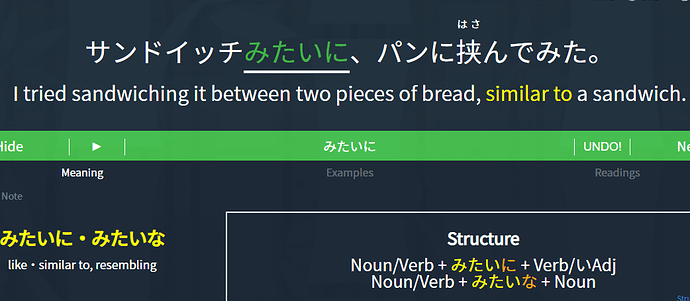Why is this みたいに instead of みたい or みたいな? Doesn’t the comma denote the end of a clause, in which case shouldn’t it just be みたい?
Hey!
みたいな is so-called prenominal form, the form used to modify nouns.
みたいに is adverbial form, the one used to modify verbs, adjectives and other adverbs.
みたい・みたいだ・みたいです etc are the end of sentence forms.
I will use very literal translations:
サンドイッチみたいに、パンに挟んでみた。
I tried to put it in between bread, in a manner similar to a sandwich. You are modifying the verb - “to put in between”, in other words, the process of putting in between is similar to(making a) sandwich.
サンドイッチみたいなパンに挟んでみた。
I tried to put it in bread that looks like(is similar in appearance to) a sandwich.
You are modifying the noun “bread”, in other words, bread is similar in appearance/looks to a sandwich.
(it is kinda hard to imagine a bread that looks like a typical sandwich, including ham made of bread, mayo made of bread etc :D).
サンドイッチみたいパンに挟んでみた。
Gramatically incorect.
By the way, past tense of てみる (to try) suggests, that a speaker managed to do it successfully.
Is パンに挟んでみた a verb phrase or a noun phrase? Is there a difference? So みたいに is for this verb phrase and it doesn’t matter if there’s a comma after it? What do Japanese commas do? Do they just separate a clause like in English?
Commas in Japanese are a recent thing since they were not used in classical Japanese. There are no real rules about usage, and you can put it anywhere you want a pause. Some writers almost do not use them, while the others put them everywhere. If you use them the way they are used in English it will be alright 
A verb phrase is a verb and its modifiers. It does not necessarily have a subject. 速く走る to run(verb) quickly(modifier)
A noun phrase is a noun and its modifiers(which are called dependents). The role of a noun phrase in a sentence (in Japanese) is determined by particle(は topic, が subject etc). 速い足 fast(modifier) legs(noun)
Since みたいに works as an adverb, it modifies a verb  And while putting the comma there is not a rule, it is still a good practice.
And while putting the comma there is not a rule, it is still a good practice.
In previous post I meant the verb specifically.
Thanks for clearing that up. Why is putting the comma there a good practice?
Because it makes it easier to read 
But is there a reason that the comma should go there and not somewhere else in the sentence? What makes the comma easier to read?

